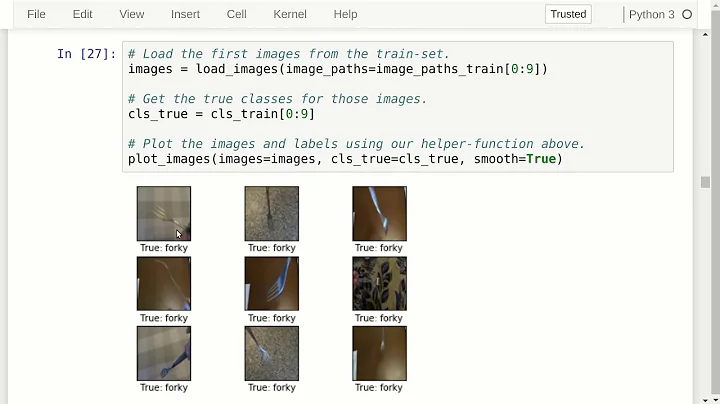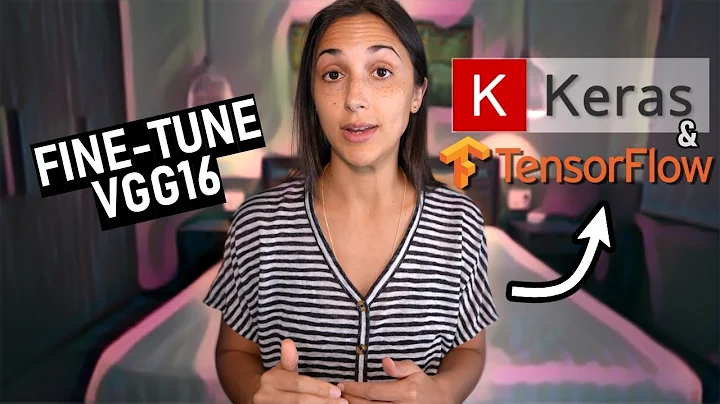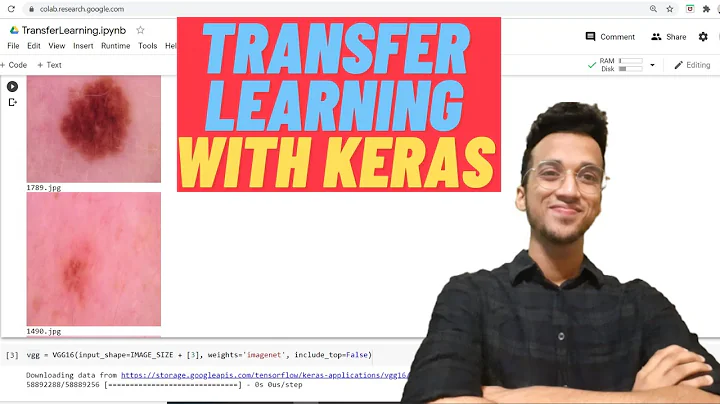Keras VGG16 fine tuning
Solution 1
I think that the weights described by the vgg net do not fit your model and the error stems from this. Anyways there is a way better way to do this using the network itself as described in (https://keras.io/applications/#vgg16).
You can just use:
base_model = keras.applications.vgg16.VGG16(include_top=False, weights='imagenet', input_tensor=None, input_shape=None)
to instantiate a vgg net that is pre-trained. Then you can freeze the layers and use the model class to instantiate your own model like this:
x = base_model.output
x = Flatten()(x)
x = Dense(your_classes, activation='softmax')(x) #minor edit
new_model = Model(input=base_model.input, output=x)
To combine the bottom and the top network you can use the following code snippet. The following functions are used (Input Layer (https://keras.io/getting-started/functional-api-guide/) / load_model (https://keras.io/getting-started/faq/#how-can-i-save-a-keras-model) and the functional API of keras):
final_input = Input(shape=(3, 224, 224))
base_model = vgg...
top_model = load_model(weights_file)
x = base_model(final_input)
result = top_model(x)
final_model = Model(input=final_input, output=result)
Solution 2
I think you can concatenate both by doing something like this:
#load vgg model
vgg_model = applications.VGG16(weights='imagenet', include_top=False, input_shape=(150, 150, 3))
print('Model loaded.')
#initialise top model
top_model = Sequential()
top_model.add(Flatten(input_shape=vgg_model.output_shape[1:]))
top_model.add(Dense(256, activation='relu'))
top_model.add(Dropout(0.5))
top_model.add(Dense(1, activation='sigmoid'))
top_model.load_weights(top_model_weights_path)
# add the model on top of the convolutional base
model = Model(input= vgg_model.input, output= top_model(vgg_model.output))
This solution refers to the example Fine-tuning the top layers of a a pre-trained network. Full code can be found here.
Solution 3
Ok, I guess Thomas and Gowtham posted correct (and more concise answers), but I wanted to share the code, which I was able to run successfully:
def train_finetuned_model(lr=1e-5, verbose=True):
file_path = get_file('vgg16.h5', VGG16_WEIGHTS_PATH, cache_subdir='models')
if verbose:
print('Building VGG16 (no-top) model to generate bottleneck features.')
vgg16_notop = build_vgg_16()
vgg16_notop.load_weights(file_path)
for _ in range(6):
vgg16_notop.pop()
vgg16_notop.compile(optimizer=RMSprop(lr=lr), loss='categorical_crossentropy', metrics=['accuracy'])
if verbose:
print('Bottleneck features generation.')
train_batches = get_batches('train', shuffle=False, class_mode=None, batch_size=BATCH_SIZE)
train_labels = np.array([0]*1000 + [1]*1000)
train_bottleneck = vgg16_notop.predict_generator(train_batches, steps=2000 // BATCH_SIZE)
valid_batches = get_batches('valid', shuffle=False, class_mode=None, batch_size=BATCH_SIZE)
valid_labels = np.array([0]*400 + [1]*400)
valid_bottleneck = vgg16_notop.predict_generator(valid_batches, steps=800 // BATCH_SIZE)
if verbose:
print('Training top model on bottleneck features.')
top_model = Sequential()
top_model.add(Flatten(input_shape=train_bottleneck.shape[1:]))
top_model.add(Dense(4096, activation='relu'))
top_model.add(Dropout(0.5))
top_model.add(Dense(4096, activation='relu'))
top_model.add(Dropout(0.5))
top_model.add(Dense(2, activation='softmax'))
top_model.compile(optimizer=RMSprop(lr=lr), loss='categorical_crossentropy', metrics=['accuracy'])
top_model.fit(train_bottleneck, to_categorical(train_labels),
batch_size=32, epochs=10,
validation_data=(valid_bottleneck, to_categorical(valid_labels)))
if verbose:
print('Concatenate new VGG16 (without top layer) with pretrained top model.')
vgg16_fine = build_vgg_16()
vgg16_fine.load_weights(file_path)
for _ in range(6):
vgg16_fine.pop()
vgg16_fine.add(Flatten(name='top_flatten'))
vgg16_fine.add(Dense(4096, activation='relu'))
vgg16_fine.add(Dropout(0.5))
vgg16_fine.add(Dense(4096, activation='relu'))
vgg16_fine.add(Dropout(0.5))
vgg16_fine.add(Dense(2, activation='softmax'))
vgg16_fine.compile(optimizer=RMSprop(lr=lr), loss='categorical_crossentropy', metrics=['accuracy'])
if verbose:
print('Loading pre-trained weights into concatenated model')
for i, layer in enumerate(reversed(top_model.layers), 1):
pretrained_weights = layer.get_weights()
vgg16_fine.layers[-i].set_weights(pretrained_weights)
for layer in vgg16_fine.layers[:26]:
layer.trainable = False
if verbose:
print('Layers training status:')
for layer in vgg16_fine.layers:
print('[%6s] %s' % ('' if layer.trainable else 'FROZEN', layer.name))
vgg16_fine.compile(optimizer=RMSprop(lr=1e-6), loss='binary_crossentropy', metrics=['accuracy'])
if verbose:
print('Train concatenated model on dogs/cats dataset sample.')
train_datagen = ImageDataGenerator(rescale=1./255,
shear_range=0.2,
zoom_range=0.2,
horizontal_flip=True)
test_datagen = ImageDataGenerator(rescale=1./255)
train_batches = get_batches('train', gen=train_datagen, class_mode='categorical', batch_size=BATCH_SIZE)
valid_batches = get_batches('valid', gen=test_datagen, class_mode='categorical', batch_size=BATCH_SIZE)
vgg16_fine.fit_generator(train_batches, epochs=100,
steps_per_epoch=2000 // BATCH_SIZE,
validation_data=valid_batches,
validation_steps=800 // BATCH_SIZE)
return vgg16_fine
It is kind of too verbose and makes all things manually (i.e. copies weights from pre-trained layers to concatenated model), but it works, more or less.
Though this code I've posted has a problem with low accuracy (around 70%), but that is a different story.
Related videos on Youtube
Comments
-
 devforfu over 1 year
devforfu over 1 yearThere is an example of VGG16 fine-tuning on keras blog, but I can't reproduce it.
More precisely, here is code used to init VGG16 without top layer and to freeze all blocks except the topmost:
WEIGHTS_PATH_NO_TOP = 'https://github.com/fchollet/deep-learning-models/releases/download/v0.1/vgg16_weights_tf_dim_ordering_tf_kernels_notop.h5' weights_path = get_file('vgg16_weights.h5', WEIGHTS_PATH_NO_TOP) model = Sequential() model.add(InputLayer(input_shape=(150, 150, 3))) model.add(Conv2D(64, (3, 3), activation='relu', padding='same')) model.add(Conv2D(64, (3, 3), activation='relu', padding='same')) model.add(MaxPooling2D((2, 2), strides=(2, 2))) model.add(Conv2D(128, (3, 3), activation='relu', padding='same')) model.add(Conv2D(128, (3, 3), activation='relu', padding='same')) model.add(MaxPooling2D((2, 2), strides=(2, 2))) model.add(Conv2D(256, (3, 3), activation='relu', padding='same')) model.add(Conv2D(256, (3, 3), activation='relu', padding='same')) model.add(Conv2D(256, (3, 3), activation='relu', padding='same')) model.add(MaxPooling2D((2, 2), strides=(2, 2))) model.add(Conv2D(512, (3, 3), activation='relu', padding='same')) model.add(Conv2D(512, (3, 3), activation='relu', padding='same')) model.add(Conv2D(512, (3, 3), activation='relu', padding='same')) model.add(MaxPooling2D((2, 2), strides=(2, 2))) model.add(Conv2D(512, (3, 3), activation='relu', padding='same', name='block5_conv1')) model.add(Conv2D(512, (3, 3), activation='relu', padding='same', name='block5_conv2')) model.add(Conv2D(512, (3, 3), activation='relu', padding='same', name='block5_conv3')) model.add(MaxPooling2D((2, 2), strides=(2, 2), name='block5_maxpool')) model.load_weights(weights_path) for layer in model.layers: layer.trainable = False for layer in model.layers[-4:]: layer.trainable = True print("Layer '%s' is trainable" % layer.name)Next, creating a top model with single hidden layer:
top_model = Sequential() top_model.add(Flatten(input_shape=model.output_shape[1:])) top_model.add(Dense(256, activation='relu')) top_model.add(Dropout(0.5)) top_model.add(Dense(1, activation='sigmoid')) top_model.load_weights('top_model.h5')Note that it was previously trained on bottleneck features like it is described in the blog post. Next, add this top model to the base model and compile:
model.add(top_model) model.compile(loss='binary_crossentropy', optimizer=SGD(lr=1e-4, momentum=0.9), metrics=['accuracy'])And eventually, fit on cats/dogs data:
batch_size = 16 train_datagen = ImageDataGenerator(rescale=1./255, shear_range=0.2, zoom_range=0.2, horizontal_flip=True) test_datagen = ImageDataGenerator(rescale=1./255) train_gen = train_datagen.flow_from_directory( TRAIN_DIR, target_size=(150, 150), batch_size=batch_size, class_mode='binary') valid_gen = test_datagen.flow_from_directory( VALID_DIR, target_size=(150, 150), batch_size=batch_size, class_mode='binary') model.fit_generator( train_gen, steps_per_epoch=nb_train_samples // batch_size, epochs=nb_epoch, validation_data=valid_gen, validation_steps=nb_valid_samples // batch_size)But here is an error I am getting when trying to fit:
ValueError: Error when checking model target: expected block5_maxpool to have 4 > dimensions, but got array with shape (16, 1)
Therefore, it seems that something is wrong with the last pooling layer in base model. Or probably I've done something wrong trying to connect base model with the top one.
Does anybody have similar issue? Or maybe there is a better way to build such "concatenated" models? I am using
keras==2.0.0withtheanobackend.Note: I was using examples from gist and
applications.VGG16utility, but has issues trying to concatenate models, I am not too familiar withkerasfunctional API. So this solution I provide here is the most "successful" one, i.e. it fails only on fitting stage.
Update #1
Ok, here is a small explanation about what I am trying to do. First of all, I am generating bottleneck features from VGG16 as follows:
def save_bottleneck_features(): datagen = ImageDataGenerator(rescale=1./255) model = applications.VGG16(include_top=False, weights='imagenet') generator = datagen.flow_from_directory( TRAIN_DIR, target_size=(150, 150), batch_size=batch_size, class_mode=None, shuffle=False) print("Predicting train samples..") bottleneck_features_train = model.predict_generator(generator, nb_train_samples) np.save(open('bottleneck_features_train.npy', 'w'), bottleneck_features_train) generator = datagen.flow_from_directory( VALID_DIR, target_size=(150, 150), batch_size=batch_size, class_mode=None, shuffle=False) print("Predicting valid samples..") bottleneck_features_valid = model.predict_generator(generator, nb_valid_samples) np.save(open('bottleneck_features_valid.npy', 'w'), bottleneck_features_valid)Then, I create a top model and train it on these features as follows:
def train_top_model(): train_data = np.load(open('bottleneck_features_train.npy')) train_labels = np.array([0]*(nb_train_samples / 2) + [1]*(nb_train_samples / 2)) valid_data = np.load(open('bottleneck_features_valid.npy')) valid_labels = np.array([0]*(nb_valid_samples / 2) + [1]*(nb_valid_samples / 2)) model = Sequential() model.add(Flatten(input_shape=train_data.shape[1:])) model.add(Dense(256, activation='relu')) model.add(Dropout(0.5)) model.add(Dense(1, activation='sigmoid')) model.compile(optimizer='rmsprop', loss='binary_crossentropy', metrics=['accuracy']) model.fit(train_data, train_labels, nb_epoch=nb_epoch, batch_size=batch_size, validation_data=(valid_data, valid_labels), verbose=1) model.save_weights('top_model.h5')So basically, there are two trained models,
base_modelwith ImageNet weights andtop_modelwith weights generated from bottleneck features. And I wonder how to concatenate them? Is it possible or I am doing something wrong? Because as I can see, the response from @thomas-pinetz supposes that the top model is not trained separately and right away appended to the model. Not sure if I am clear, here is a quote from the blog:In order to perform fine-tuning, all layers should start with properly trained weights: for instance you should not slap a randomly initialized fully-connected network on top of a pre-trained convolutional base. This is because the large gradient updates triggered by the randomly initialized weights would wreck the learned weights in the convolutional base. In our case this is why we first train the top-level classifier, and only then start fine-tuning convolutional weights alongside it.
-
 devforfu about 7 yearsDo you know, if it is possible to deal with bottleneck features using your snippet? I mean, in the referred blog, VGG16 initialized with pretrained weights and then is used to generate bottleneck features. Then, the top model with custom classes created and trained on these features. And only at the end, these two models re-initialized with their weights, concatenated, and applied to new data. Am I right that the same is possible with your code? I think I had some troubles trying something similar to your suggestion.
devforfu about 7 yearsDo you know, if it is possible to deal with bottleneck features using your snippet? I mean, in the referred blog, VGG16 initialized with pretrained weights and then is used to generate bottleneck features. Then, the top model with custom classes created and trained on these features. And only at the end, these two models re-initialized with their weights, concatenated, and applied to new data. Am I right that the same is possible with your code? I think I had some troubles trying something similar to your suggestion. -
 Thomas Pinetz about 7 yearsThe bottleneck features are the imagenet features i used in this snippet. There is a code sample that does what you want here: keras.io/applications. Additionally what is the error?
Thomas Pinetz about 7 yearsThe bottleneck features are the imagenet features i used in this snippet. There is a code sample that does what you want here: keras.io/applications. Additionally what is the error? -
 devforfu about 7 yearsI have added a couple of extra sections to the question. Not sure if what I am trying to do is different from your advice or if it doesn't make too much sense. Briefly, I am trying to concatenate two separately networks into one sequential model. And in your snippet the "top model" (created in a functional way) is not trained yet, right?
devforfu about 7 yearsI have added a couple of extra sections to the question. Not sure if what I am trying to do is different from your advice or if it doesn't make too much sense. Briefly, I am trying to concatenate two separately networks into one sequential model. And in your snippet the "top model" (created in a functional way) is not trained yet, right? -
 Thomas Pinetz about 7 yearsEdited answer to match your follow up question.
Thomas Pinetz about 7 yearsEdited answer to match your follow up question. -
 Gowtham Ramesh almost 7 yearsdon't forget to import Model from keras.models
Gowtham Ramesh almost 7 yearsdon't forget to import Model from keras.models -
skeller88 over 4 yearsHow did you decide how many layers to unfreeze when fine-tuning? I have that question for VGG16 and transfer learning in general.
-
 devforfu over 4 years@skeller88 I would say that it depends on how different your dataset is from the dataset on which the original model was trained. If the domains are similar (like in this case, cats/dogs photos), you fine-tune the topmost fully-connected layers, and maybe the last few convolution layers a bit. However, if you domain is very different from ImageNet images (i.e., X-ray images, microscopy, materials, etc.), the more fine-tuning is required. Probably you'll need to gradually unfreeze all layers and re-train them using appropriate learning rates.
devforfu over 4 years@skeller88 I would say that it depends on how different your dataset is from the dataset on which the original model was trained. If the domains are similar (like in this case, cats/dogs photos), you fine-tune the topmost fully-connected layers, and maybe the last few convolution layers a bit. However, if you domain is very different from ImageNet images (i.e., X-ray images, microscopy, materials, etc.), the more fine-tuning is required. Probably you'll need to gradually unfreeze all layers and re-train them using appropriate learning rates.







